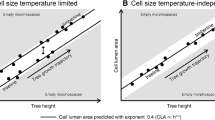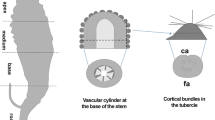Summary
Two radial samples were sawn from nine levels in a single tree ofPinus kesiya Royle ex Gord. (syn.P. khasya, P. insularis). Twentyfive tracheids were measured on two microscope slides for the earlywood of rings 2... 21 in each radial sample. The statistically significant difference between radii had litile practical importance and the systematic difference between rings was consistent over all levels. The effect of differences between levels was important and multiple regressions were calculated, incorporating linear and quadratic effects of ring number and height in stem. The best model accounted for 82% of the total variation. Exponential regressions were calculated for each level independently (75... 89%) and for the entire tree (77%). Both types of model are acceptable for description of variation up to ring 21 but beyond this ring number the exponential model will be most useful for description and prediction. For future work the minimum sampling strategy per tree will be three levels, two radii per level, and three or four rings per radius if quadratic models are required; five or six rings will be necessary to fix exponential models.
Zusammenfassung
Jeweils zwei Radialproben wurden in neun verschiedenen Höhen aus einem Stamm vonPinus kesiya Royle ex Gord. entnommen. Von jeder Radialprobe wurden 25 Tracheiden an zwei Mikropräparaten des Frühholzes der Jahrringe 2... 21 vermessen. Die statistisch signifikante Differenz in den Tracheidenhalbmessern war von untergeordneter praktischer Bedeutung. Die systematische Differenz zwischen den Jahrringen blieb in allen Stammhöhen gleich. Dagegen erwies sich der Einfluß des Abstandes zwischen den einzelnen Stammhöhen als bedeutsam; multiple Regressionen unter Berücksichtigung der linearen und quadratischen Jahrringzahl sowie der Höhe im Stamm wurden berechnet. Mit dem günstigsten Ansatz konnten 82% der Gesamtvariation erklärt werden. Exponentielle Regressionen wurden für jede Stammscheibenhöhe (75... 89%) und für den ganzen Stamm (77%) berechnet. Beide Ansätze sind zur Beschreibung der Variation bis zum Jahrring 21 geeignet, unterhalb dieses Jahrringes ist der exponentielle Ansatz für die Beschreibung und Voraussage vorzuziehen. Für künftige Prüfungen wird die Mindestentnahme je Stamm sein: drei verschiedene Stammhöhen, zwei Radialproben je Höhe und drei bis vier Jahrringe je Radialprobe bei Verwendung des quadratischen Ansatzes; für den exponentiellen Ansatz ist die Prüfung von fünf bis sechs Jahrringen notwendig.
Similar content being viewed by others
References
Anonymous: Fibre identification for the Philippines' pulp and paper industry. For. Prod. Res. Inst., Laguna, Philippines, Tech. Note 43 (1963) 9 pp.
Burley, J., P. M. Burrows, J. V. Pattinson andA. Press: Tracheid length measurement techniques for small wood samples. Rhod. Zamb. Mal. J. Agric. Res.5 (1967) 289–296
Elliott, G. K., Distribution of tracheid length in a single stem of Sitka spruce. J. Inst. Wood Sci.5 (1960) 38–47
Höpner, T.: Pulp fibres and plant classification. (In German). Papier11 (1957) 229–237.
Piesslinger-Schweiger, W: Industrial trials of fibrous material from Vietnam suitable for the development of a national paper industry. (In French.) FAO Summary Rept. 59/8/5961, Rome (1959) 32 pp.
Petroff, G., J. Doat andM. Tissot: Paper-making qualities of some tropical species used in afforestation. Vol. III (In French.) Publ. Centre Tech. For. Trop.31 (1968) 195 pp.
Author information
Authors and Affiliations
Additional information
Work initiated while Geneticist in Charge, Tree Improvement Research Centre, Agricultural Research Council of Zambia, Kitwe, Zambia.
The author wishes to acknowledge the laboratory assistance of MissPenelope Waters. Mr. H. L. Wright assisted with the exponential regression analyses. Data was processed on the KDF 9 computer at the Oxford University Computer Laboratory. This paper is published with the permission of Director, Agricultural Research Council of Zambia, and Acting Professor of Forestry, Oxford University.
Rights and permissions
About this article
Cite this article
Burley, J. Tracheid length variation in a single tree ofPinus kesiya Royle ex Gord.. Wood Sci.Technol. 3, 109–116 (1969). https://doi.org/10.1007/BF00639635
Issue Date:
DOI: https://doi.org/10.1007/BF00639635




